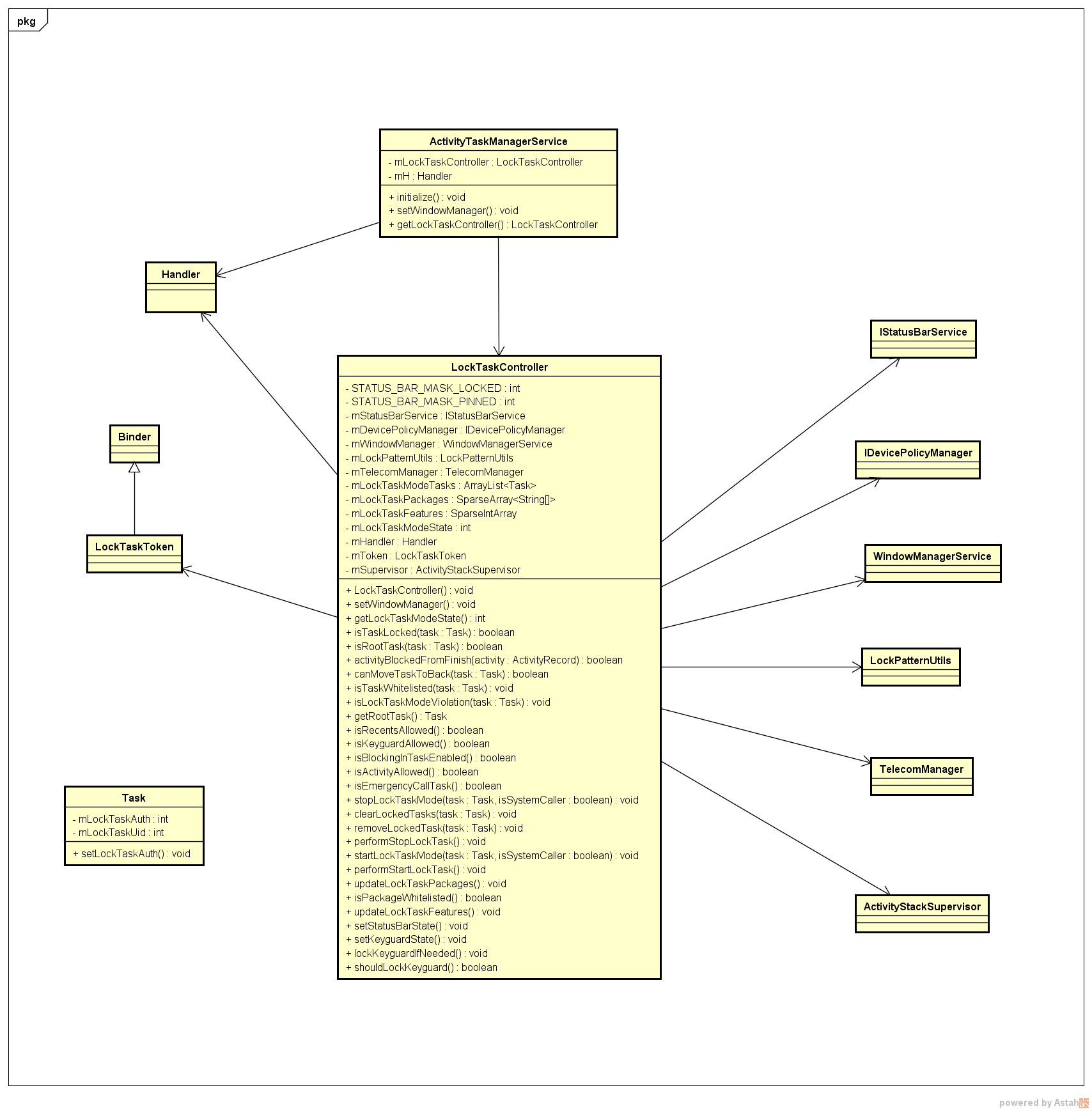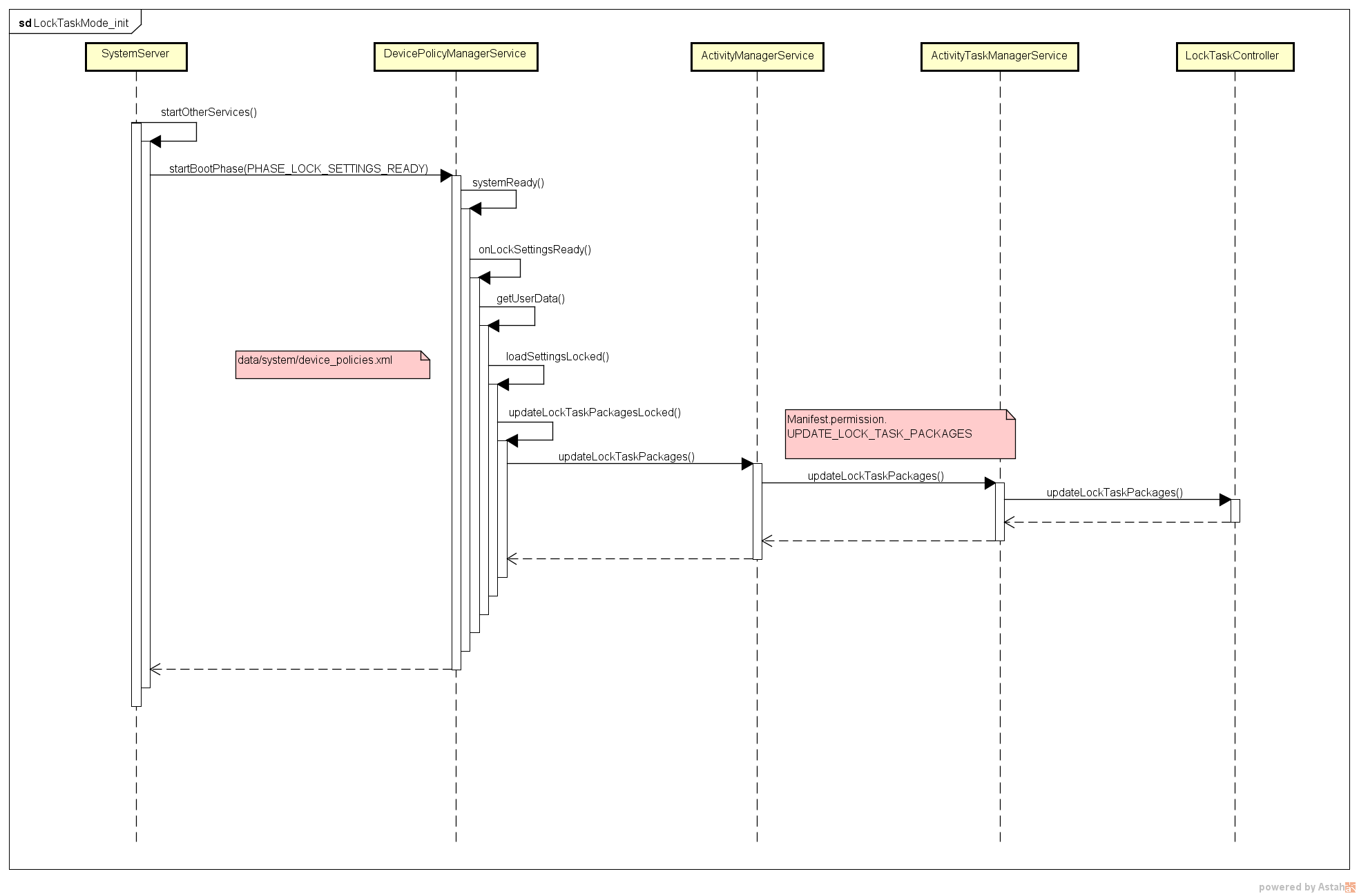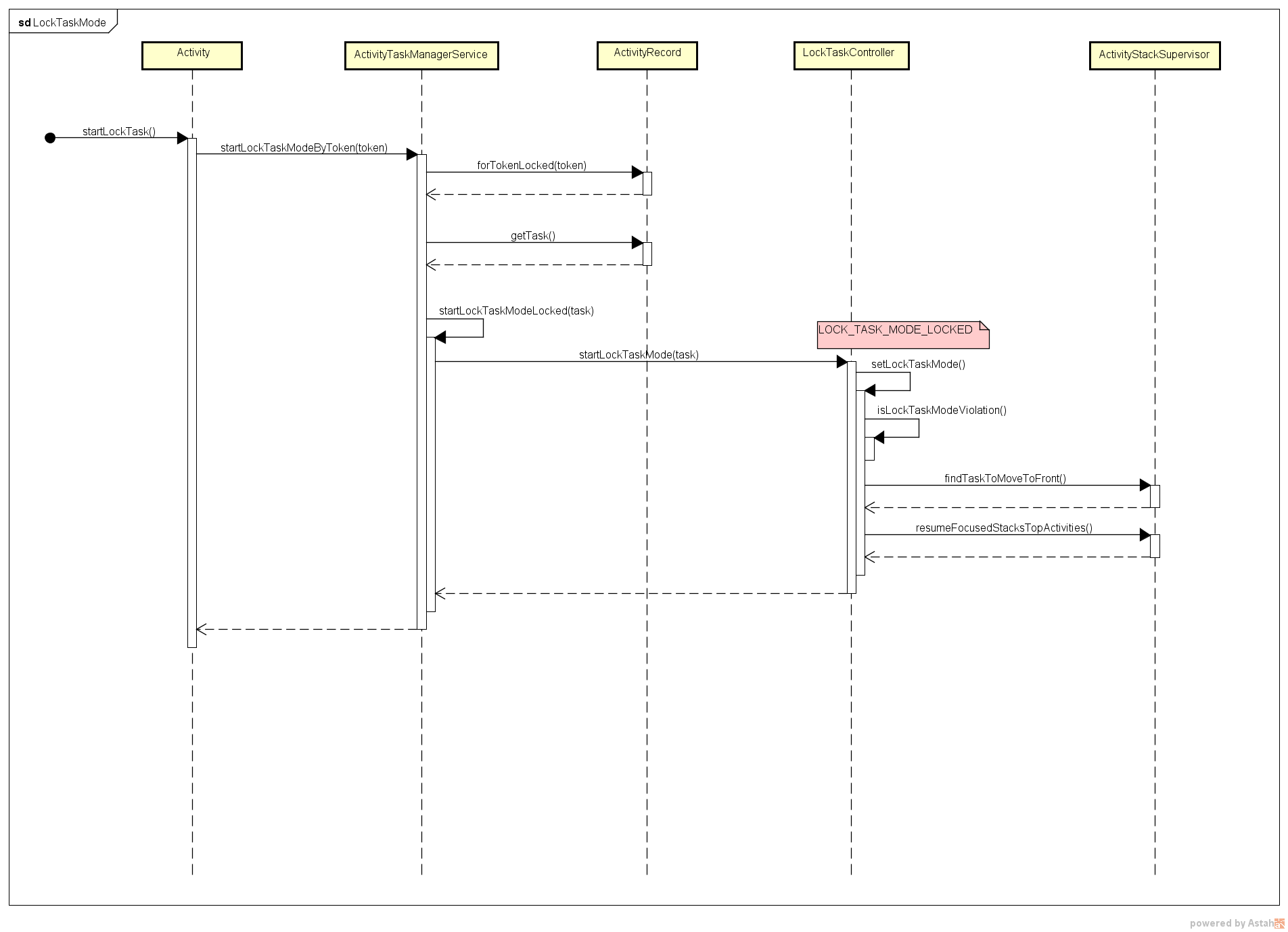DeviceOwner
adb shell dpm set-device-owner net.derohimat.kioskmodesample/.AdminReceiver
public final class Dpm extends BaseCommand {
private void runSetDeviceOwner() throws RemoteException {
parseArgs(/*canHaveName=*/ true);
mDevicePolicyManager.setActiveAdmin(mComponent, true /*refreshing*/, mUserId);
try {
if (!mDevicePolicyManager.setDeviceOwner(mComponent, mName, mUserId)) {
throw new RuntimeException(
"Can't set package " + mComponent + " as device owner.");
}
} catch (Exception e) {
// Need to remove the admin that we just added.
mDevicePolicyManager.removeActiveAdmin(mComponent, UserHandle.USER_SYSTEM);
throw e;
}
mDevicePolicyManager.setUserProvisioningState(
DevicePolicyManager.STATE_USER_SETUP_FINALIZED, mUserId);
System.out.println("Success: Device owner set to package " + mComponent);
System.out.println("Active admin set to component " + mComponent.toShortString());
}
}
App 代码
public class BaseActivity extends AppCompatActivity {
protected void setUpAdmin() {
if (true) {
ComponentName deviceAdmin = new ComponentName(this, AdminReceiver.class);
mDpm = (DevicePolicyManager) getSystemService(Context.DEVICE_POLICY_SERVICE);
if (!mDpm.isAdminActive(deviceAdmin)) {
Log.e("Kiosk Mode Error", getString(R.string.not_device_admin));
}
if (mDpm.isDeviceOwnerApp(getPackageName())) {
mDpm.setLockTaskPackages(deviceAdmin, new String[]{getPackageName()});
} else {
Log.e("Kiosk Mode Error", getString(R.string.not_device_owner));
}
enableKioskMode(true);
}
mDecorView = getWindow().getDecorView();
hideSystemUI();
}
protected void enableKioskMode(boolean enabled) {
try {
if (enabled) {
if (mDpm.isLockTaskPermitted(this.getPackageName())) {
startLockTask();
} else {
Log.e("Kiosk Mode Error", getString(R.string.kiosk_not_permitted));
}
} else {
stopLockTask();
}
} catch (Exception e) {
Log.e("Kiosk Mode Error", e.getMessage());
}
}
protected void hideSystemUI() {
mDecorView.setSystemUiVisibility(
View.SYSTEM_UI_FLAG_LAYOUT_STABLE
| View.SYSTEM_UI_FLAG_LAYOUT_HIDE_NAVIGATION
| View.SYSTEM_UI_FLAG_LAYOUT_FULLSCREEN
| View.SYSTEM_UI_FLAG_HIDE_NAVIGATION // hide nav bar
| View.SYSTEM_UI_FLAG_FULLSCREEN // hide status bar
| View.SYSTEM_UI_FLAG_IMMERSIVE_STICKY);
}
}
DevicePolicyManagerService
data/system/device_policies.xml
1|qssi:/ # cat data/system/device_policies.xml
<?xml version='1.0' encoding='utf-8' standalone='yes' ?>
<policies setup-complete="true" provisioning-state="3">
<admin name="com.***.remotecontrol.pro/com.***.remotecontrol.receiver.MyAdminReceiver">
<policies flags="991" />
<strong-auth-unlock-timeout value="0" />
<cross-profile-calendar-packages />
<cross-profile-packages />
</admin>
<admin name="net.derohimat.kioskmodesample/net.derohimat.kioskmodesample.AdminReceiver">
<policies flags="0" />
<strong-auth-unlock-timeout value="0" />
<test-only-admin value="true" />
<cross-profile-calendar-packages />
<cross-profile-packages />
</admin>
<lock-task-component name="net.derohimat.kioskmodesample" />
<lock-task-component name="com.sunmi.superpermissiontest" />
<lock-task-component name="com.android.settings" />
<lock-task-features value="16" />
</policies>
DevicePolicyManager
public class DevicePolicyManager {
/**
* Disable all configurable SystemUI features during LockTask mode. This includes,
* <ul>
* <li>system info area in the status bar (connectivity icons, clock, etc.)
* <li>notifications (including alerts, icons, and the notification shade)
* <li>Home button
* <li>Recents button and UI
* <li>global actions menu (i.e. power button menu)
* <li>keyguard
* </ul>
*
* @see #setLockTaskFeatures(ComponentName, int)
*/
public static final int LOCK_TASK_FEATURE_NONE = 0;
/**
* Enable the system info area in the status bar during LockTask mode. The system info area
* usually occupies the right side of the status bar (although this can differ across OEMs). It
* includes all system information indicators, such as date and time, connectivity, battery,
* vibration mode, etc.
*
* @see #setLockTaskFeatures(ComponentName, int)
*/
public static final int LOCK_TASK_FEATURE_SYSTEM_INFO = 1; // 状态栏显示 1
/**
* Enable notifications during LockTask mode. This includes notification icons on the status
* bar, heads-up notifications, and the expandable notification shade. Note that the Quick
* Settings panel remains disabled. This feature flag can only be used in combination with
* {@link #LOCK_TASK_FEATURE_HOME}. {@link #setLockTaskFeatures(ComponentName, int)}
* throws an {@link IllegalArgumentException} if this feature flag is defined without
* {@link #LOCK_TASK_FEATURE_HOME}.
*
* @see #setLockTaskFeatures(ComponentName, int)
*/
public static final int LOCK_TASK_FEATURE_NOTIFICATIONS = 1 << 1; // 通知显示 2
/**
* Enable the Home button during LockTask mode. Note that if a custom launcher is used, it has
* to be registered as the default launcher with
* {@link #addPersistentPreferredActivity(ComponentName, IntentFilter, ComponentName)}, and its
* package needs to be whitelisted for LockTask with
* {@link #setLockTaskPackages(ComponentName, String[])}.
*
* @see #setLockTaskFeatures(ComponentName, int)
*/
public static final int LOCK_TASK_FEATURE_HOME = 1 << 2; // Home按钮 4
/**
* Enable the Overview button and the Overview screen during LockTask mode. This feature flag
* can only be used in combination with {@link #LOCK_TASK_FEATURE_HOME}, and
* {@link #setLockTaskFeatures(ComponentName, int)} will throw an
* {@link IllegalArgumentException} if this feature flag is defined without
* {@link #LOCK_TASK_FEATURE_HOME}.
*
* @see #setLockTaskFeatures(ComponentName, int)
*/
public static final int LOCK_TASK_FEATURE_OVERVIEW = 1 << 3; // 8
/**
* Enable the global actions dialog during LockTask mode. This is the dialog that shows up when
* the user long-presses the power button, for example. Note that the user may not be able to
* power off the device if this flag is not set.
*
* <p>This flag is enabled by default until {@link #setLockTaskFeatures(ComponentName, int)} is
* called for the first time.
*
* @see #setLockTaskFeatures(ComponentName, int)
*/
public static final int LOCK_TASK_FEATURE_GLOBAL_ACTIONS = 1 << 4; // 16
/**
* Enable the keyguard during LockTask mode. Note that if the keyguard is already disabled with
* {@link #setKeyguardDisabled(ComponentName, boolean)}, setting this flag will have no effect.
* If this flag is not set, the keyguard will not be shown even if the user has a lock screen
* credential.
*
* @see #setLockTaskFeatures(ComponentName, int)
*/
public static final int LOCK_TASK_FEATURE_KEYGUARD = 1 << 5; // 32
/**
* Enable blocking of non-whitelisted activities from being started into a locked task.
*
* @see #setLockTaskFeatures(ComponentName, int)
*/
public static final int LOCK_TASK_FEATURE_BLOCK_ACTIVITY_START_IN_TASK = 1 << 6; // 64
/**
* Flags supplied to {@link #setLockTaskFeatures(ComponentName, int)}.
*
* @hide
*/
@Retention(RetentionPolicy.SOURCE)
@IntDef(flag = true, prefix = { "LOCK_TASK_FEATURE_" }, value = {
LOCK_TASK_FEATURE_NONE,
LOCK_TASK_FEATURE_SYSTEM_INFO,
LOCK_TASK_FEATURE_NOTIFICATIONS,
LOCK_TASK_FEATURE_HOME,
LOCK_TASK_FEATURE_OVERVIEW,
LOCK_TASK_FEATURE_GLOBAL_ACTIONS,
LOCK_TASK_FEATURE_KEYGUARD,
LOCK_TASK_FEATURE_BLOCK_ACTIVITY_START_IN_TASK
})
public @interface LockTaskFeature {}
}
DevicePolicyManagerService
public class DevicePolicyManagerService extends BaseIDevicePolicyManager {
/**
* Sets which packages may enter lock task mode.
* <p>
* Any packages that share uid with an allowed package will also be allowed to activate lock
* task. From {@link android.os.Build.VERSION_CODES#M} removing packages from the lock task
* package list results in locked tasks belonging to those packages to be finished.
* <p>
* This function can only be called by the device owner, a profile owner of an affiliated user
* or profile, or the profile owner when no device owner is set. See {@link #isAffiliatedUser}.
* Any package set via this method will be cleared if the user becomes unaffiliated.
*
* @param packages The list of packages allowed to enter lock task mode
* @param admin Which {@link DeviceAdminReceiver} this request is associated with.
* @throws SecurityException if {@code admin} is not the device owner, the profile owner of an
* affiliated user or profile, or the profile owner when no device owner is set.
* @see #isAffiliatedUser
* @see Activity#startLockTask()
* @see DeviceAdminReceiver#onLockTaskModeEntering(Context, Intent, String)
* @see DeviceAdminReceiver#onLockTaskModeExiting(Context, Intent)
* @see UserManager#DISALLOW_CREATE_WINDOWS
*/
@Override
public void setLockTaskPackages(ComponentName who, String[] packages)
throws SecurityException {
Objects.requireNonNull(who, "ComponentName is null");
Objects.requireNonNull(packages, "packages is null");
synchronized (getLockObject()) {
enforceCanCallLockTaskLocked(who);
final int userHandle = mInjector.userHandleGetCallingUserId();
setLockTaskPackagesLocked(userHandle, new ArrayList<>(Arrays.asList(packages)));
}
}
private void setLockTaskPackagesLocked(int userHandle, List<String> packages) {
DevicePolicyData policy = getUserData(userHandle);
policy.mLockTaskPackages = packages;
// Store the settings persistently.
saveSettingsLocked(userHandle);
updateLockTaskPackagesLocked(packages, userHandle);
}
/**
* This function lets the caller know whether the given component is allowed to start the
* lock task mode.
* @param pkg The package to check
*/
@Override
public boolean isLockTaskPermitted(String pkg) {
final int userHandle = mInjector.userHandleGetCallingUserId();
synchronized (getLockObject()) {
return getUserData(userHandle).mLockTaskPackages.contains(pkg);
}
}
public static class DevicePolicyData {
// This is the list of component allowed to start lock task mode.
List<String> mLockTaskPackages = new ArrayList<>();
}
}
ActivityTaskManagerService

Activity
/**
* Request to put this activity in a mode where the user is locked to a restricted set of
* applications.
*
* <p>If {@link DevicePolicyManager#isLockTaskPermitted(String)} returns {@code true}
* for this component, the current task will be launched directly into LockTask mode. Only apps
* whitelisted by {@link DevicePolicyManager#setLockTaskPackages(ComponentName, String[])} can
* be launched while LockTask mode is active. The user will not be able to leave this mode
* until this activity calls {@link #stopLockTask()}. Calling this method while the device is
* already in LockTask mode has no effect.
*
* <p>Otherwise, the current task will be launched into screen pinning mode. In this case, the
* system will prompt the user with a dialog requesting permission to use this mode.
* The user can exit at any time through instructions shown on the request dialog. Calling
* {@link #stopLockTask()} will also terminate this mode.
*
* <p><strong>Note:</strong> this method can only be called when the activity is foreground.
* That is, between {@link #onResume()} and {@link #onPause()}.
*
* @see #stopLockTask()
* @see android.R.attr#lockTaskMode
*/
public void startLockTask() {
try {
ActivityTaskManager.getService().startLockTaskModeByToken(mToken);
} catch (RemoteException e) {
}
}
/**
* Stop the current task from being locked.
*
* <p>Called to end the LockTask or screen pinning mode started by {@link #startLockTask()}.
* This can only be called by activities that have called {@link #startLockTask()} previously.
*
* <p><strong>Note:</strong> If the device is in LockTask mode that is not initially started
* by this activity, then calling this method will not terminate the LockTask mode, but only
* finish its own task. The device will remain in LockTask mode, until the activity which
* started the LockTask mode calls this method, or until its whitelist authorization is revoked
* by {@link DevicePolicyManager#setLockTaskPackages(ComponentName, String[])}.
*
* @see #startLockTask()
* @see android.R.attr#lockTaskMode
* @see ActivityManager#getLockTaskModeState()
*/
public void stopLockTask() {
try {
ActivityTaskManager.getService().stopLockTaskModeByToken(mToken);
} catch (RemoteException e) {
}
}
ActivityTaskManagerService
/**
* System service for managing activities and their containers (task, stacks, displays,... ).
*
* {@hide}
*/
public class ActivityTaskManagerService extends IActivityTaskManager.Stub {
private LockTaskController mLockTaskController;
public void initialize(IntentFirewall intentFirewall, PendingIntentController intentController,
Looper looper) {
mLockTaskController = new LockTaskController(mContext, mStackSupervisor, mH);
}
public void setWindowManager(WindowManagerService wm) {
synchronized (mGlobalLock) {
mLockTaskController.setWindowManager(wm);
}
}
LockTaskController getLockTaskController() {
return mLockTaskController;
}
@Override
public void startLockTaskModeByToken(IBinder token) {
synchronized (mGlobalLock) {
final ActivityRecord r = ActivityRecord.forTokenLocked(token);
if (r == null) {
return;
}
startLockTaskModeLocked(r.getTask(), false /* isSystemCaller */);
}
}
@Override
public void startSystemLockTaskMode(int taskId) {
mAmInternal.enforceCallingPermission(MANAGE_ACTIVITY_STACKS, "startSystemLockTaskMode");
// This makes inner call to look as if it was initiated by system.
long ident = Binder.clearCallingIdentity();
try {
synchronized (mGlobalLock) {
final Task task = mRootWindowContainer.anyTaskForId(taskId,
MATCH_TASK_IN_STACKS_ONLY);
if (task == null) {
return;
}
// When starting lock task mode the stack must be in front and focused
task.getStack().moveToFront("startSystemLockTaskMode");
startLockTaskModeLocked(task, true /* isSystemCaller */);
}
} finally {
Binder.restoreCallingIdentity(ident);
}
}
private void startLockTaskModeLocked(@Nullable Task task, boolean isSystemCaller) {
if (DEBUG_LOCKTASK) Slog.w(TAG_LOCKTASK, "startLockTaskModeLocked: " + task);
if (task == null || task.mLockTaskAuth == LOCK_TASK_AUTH_DONT_LOCK) {
return;
}
final ActivityStack stack = mRootWindowContainer.getTopDisplayFocusedStack();
if (stack == null || task != stack.getTopMostTask()) {
throw new IllegalArgumentException("Invalid task, not in foreground");
}
// {@code isSystemCaller} is used to distinguish whether this request is initiated by the
// system or a specific app.
// * System-initiated requests will only start the pinned mode (screen pinning)
// * App-initiated requests
// - will put the device in fully locked mode (LockTask), if the app is whitelisted
// - will start the pinned mode, otherwise
final int callingUid = Binder.getCallingUid();
long ident = Binder.clearCallingIdentity();
try {
// When a task is locked, dismiss the pinned stack if it exists
mRootWindowContainer.removeStacksInWindowingModes(WINDOWING_MODE_PINNED);
getLockTaskController().startLockTaskMode(task, isSystemCaller, callingUid);
} finally {
Binder.restoreCallingIdentity(ident);
}
}
}
ActivityManager
public class ActivityManager {
/**
* Lock task mode is not active.
*/
public static final int LOCK_TASK_MODE_NONE = 0;
/**
* Full lock task mode is active.
*/
public static final int LOCK_TASK_MODE_LOCKED = 1; // 任务锁定
/**
* App pinning mode is active.
*/
public static final int LOCK_TASK_MODE_PINNED = 2; // 屏幕固定
}
Task
class Task extends WindowContainer<WindowContainer> {
/** Can't be put in lockTask mode. */
// 无法设置为locktask Mode
final static int LOCK_TASK_AUTH_DONT_LOCK = 0;
/** Can enter app pinning with user approval. Can never start over existing lockTask task. */
// 屏幕固定
final static int LOCK_TASK_AUTH_PINNABLE = 1;
// 可以从locktask跳转出来
/** Starts in LOCK_TASK_MODE_LOCKED automatically. Can start over existing lockTask task. */
final static int LOCK_TASK_AUTH_LAUNCHABLE = 2;
// 可以从locktask跳转出来
/** Can enter lockTask without user approval. Can start over existing lockTask task. */
final static int LOCK_TASK_AUTH_WHITELISTED = 3;
// 可以从locktask跳转出来
/** Priv-app that starts in LOCK_TASK_MODE_LOCKED automatically. Can start over existing
* lockTask task. */
final static int LOCK_TASK_AUTH_LAUNCHABLE_PRIV = 4;
int mLockTaskAuth = LOCK_TASK_AUTH_PINNABLE;
int mLockTaskUid = -1; // The uid of the application that called startLockTask().
}
LockTaskController
/**
* Helper class that deals with all things related to task locking. This includes the screen pinning
* mode that can be launched via System UI as well as the fully locked mode that can be achieved
* on fully managed devices.
*
* Note: All methods in this class should only be called with the ActivityTaskManagerService lock
* held.
*
* @see Activity#startLockTask()
* @see Activity#stopLockTask()
*/
public class LockTaskController {
/**
* Method to start lock task mode on a given task.
*
* @param task the task that should be locked.
* @param isSystemCaller indicates whether this request was initiated by the system via
* {@link ActivityTaskManagerService#startSystemLockTaskMode(int)}. If
* {@code true}, this intends to start pinned mode; otherwise, we look
* at the calling task's mLockTaskAuth to decide which mode to start.
* @param callingUid the caller that requested the launch of lock task mode.
*/
void startLockTaskMode(@NonNull Task task, boolean isSystemCaller, int callingUid) {
if (!isSystemCaller) {
task.mLockTaskUid = callingUid;
if (task.mLockTaskAuth == LOCK_TASK_AUTH_PINNABLE) {
// startLockTask() called by app, but app is not part of lock task whitelist. Show
// app pinning request. We will come back here with isSystemCaller true.
if (DEBUG_LOCKTASK) Slog.w(TAG_LOCKTASK, "Mode default, asking user");
StatusBarManagerInternal statusBarManager = LocalServices.getService(
StatusBarManagerInternal.class);
if (statusBarManager != null) {
statusBarManager.showScreenPinningRequest(task.mTaskId);
}
return;
}
}
// System can only initiate screen pinning, not full lock task mode
if (DEBUG_LOCKTASK) Slog.w(TAG_LOCKTASK,
isSystemCaller ? "Locking pinned" : "Locking fully");
setLockTaskMode(task, isSystemCaller ? LOCK_TASK_MODE_PINNED : LOCK_TASK_MODE_LOCKED,
"startLockTask", true);
}
/**
* Update packages that are allowed to be launched in lock task mode.
* @param userId Which user this whitelist is associated with
* @param packages The whitelist of packages allowed in lock task mode
* @see #mLockTaskPackages
*/
void updateLockTaskPackages(int userId, String[] packages) {
boolean taskChanged = false;
for (int taskNdx = mLockTaskModeTasks.size() - 1; taskNdx >= 0; --taskNdx) {
final Task lockedTask = mLockTaskModeTasks.get(taskNdx);
final boolean wasWhitelisted = lockedTask.mLockTaskAuth == LOCK_TASK_AUTH_LAUNCHABLE
|| lockedTask.mLockTaskAuth == LOCK_TASK_AUTH_WHITELISTED;
lockedTask.setLockTaskAuth();
final boolean isWhitelisted = lockedTask.mLockTaskAuth == LOCK_TASK_AUTH_LAUNCHABLE
|| lockedTask.mLockTaskAuth == LOCK_TASK_AUTH_WHITELISTED;
if (mLockTaskModeState != LOCK_TASK_MODE_LOCKED
|| lockedTask.mUserId != userId
|| !wasWhitelisted || isWhitelisted) {
continue;
}
// Terminate locked tasks that have recently lost whitelist authorization.
if (DEBUG_LOCKTASK) Slog.d(TAG_LOCKTASK, "onLockTaskPackagesUpdated: removing " +
lockedTask + " mLockTaskAuth()=" + lockedTask.lockTaskAuthToString());
removeLockedTask(lockedTask);
lockedTask.performClearTaskLocked();
taskChanged = true;
}
mSupervisor.mRootWindowContainer.forAllTasks(Task::setLockTaskAuth);
final ActivityRecord r = mSupervisor.mRootWindowContainer.topRunningActivity();
final Task task = (r != null) ? r.getTask() : null;
if (mLockTaskModeTasks.isEmpty() && task!= null
&& task.mLockTaskAuth == LOCK_TASK_AUTH_LAUNCHABLE) {
// This task must have just been authorized.
if (DEBUG_LOCKTASK) Slog.d(TAG_LOCKTASK,
"onLockTaskPackagesUpdated: starting new locktask task=" + task);
setLockTaskMode(task, LOCK_TASK_MODE_LOCKED, "package updated", false);
taskChanged = true;
}
if (taskChanged) {
mSupervisor.mRootWindowContainer.resumeFocusedStacksTopActivities();
}
}
/**
* Update the UI features that are enabled for LockTask mode.
* @param userId Which user these feature flags are associated with
* @param flags Bitfield of feature flags
* @see DevicePolicyManager#setLockTaskFeatures(ComponentName, int)
*/
void updateLockTaskFeatures(int userId, int flags) {
int oldFlags = getLockTaskFeaturesForUser(userId);
if (flags == oldFlags) {
return;
}
mLockTaskFeatures.put(userId, flags);
if (!mLockTaskModeTasks.isEmpty() && userId == mLockTaskModeTasks.get(0).mUserId) {
mHandler.post(() -> {
if (mLockTaskModeState == LOCK_TASK_MODE_LOCKED) {
setStatusBarState(mLockTaskModeState, userId);
setKeyguardState(mLockTaskModeState, userId);
}
});
}
}
}
时序图
开机初始化—updateLockTaskPackages—updateLockTaskFeaturesLocked

进入Lock Task Mode

跳转拦截日志
// 进入LockTaskMode
system_process I/ActivityTaskManager: START u0 {act=android.intent.action.MAIN cat=[android.intent.category.LAUNCHER] flg=0x10200000 cmp=com.sunmi.superpermissiontest/.MainActivity bnds=[249,415][471,634]} from uid 10131
system_process W/ActivityTaskManager_LockTask: Locking fully
system_process W/ActivityTaskManager_LockTask: setLockTaskMode: Locking to Task{76c588 #160 visible=false type=standard mode=fullscreen translucent=true A=10170:com.sunmi.superpermissiontest U=0 StackId=160 sz=1} Callers=com.android.server.wm.LockTaskController.startLockTaskMode:574 com.android.server.wm.ActivityStackSupervisor.realStartActivityLocked:839 com.android.server.wm.ActivityStackSupervisor.startSpecificActivity:1020 com.android.server.wm.ActivityStack.resumeTopActivityInnerLocked:2018
system_process W/ActivityTaskManager_LockTask: startLockTaskModeLocked: Task{76c588 #160 visible=false type=standard mode=fullscreen translucent=true A=10170:com.sunmi.superpermissiontest U=0 StackId=160 sz=1}
system_process W/ActivityTaskManager_LockTask: Locking fully
system_process W/ActivityTaskManager_LockTask: setLockTaskMode: Locking to Task{76c588 #160 visible=false type=standard mode=fullscreen translucent=true A=10170:com.sunmi.superpermissiontest U=0 StackId=160 sz=1} Callers=com.android.server.wm.LockTaskController.startLockTaskMode:574 com.android.server.wm.ActivityTaskManagerService.startLockTaskModeLocked:3061 com.android.server.wm.ActivityTaskManagerService.startLockTaskModeByToken:2991 android.app.IActivityTaskManager$Stub.onTransact:2461
// BACK 按键
system_process I/ActivityTaskManager: Not finishing task in lock task mode
// HOME 按键
system_process I/ActivityTaskManager: START u0 {act=android.intent.action.MAIN cat=[android.intent.category.HOME] flg=0x10000100 cmp=com.android.launcher3/.uioverrides.QuickstepLauncher (has extras)} from uid 0
system_process V/ActivityTaskManager: Calling mServicetracker.OnActivityStateChange with flag falsestateINITIALIZING
system_process V/ActivityTaskManager: Calling mServicetracker.OnActivityStateChange with flag truestateINITIALIZING
system_process E/ActivityTaskManager: Attempted Lock Task Mode violation mStartActivity=ActivityRecord{6b12f3a u0 com.android.launcher3/.uioverrides.QuickstepLauncher
// RECENT 按键
system_process I/ActivityTaskManager: START u0 {act=android.intent.action.MAIN cat=[android.intent.category.HOME] flg=0x10000000 pkg=com.android.launcher3 cmp=com.android.launcher3/.uioverrides.QuickstepLauncher (has extras)} from uid 10131
system_process V/ActivityTaskManager: Calling mServicetracker.OnActivityStateChange with flag falsestateINITIALIZING
system_process V/ActivityTaskManager: Calling mServicetracker.OnActivityStateChange with flag truestateINITIALIZING
system_process E/ActivityTaskManager: Attempted Lock Task Mode violation mStartActivity=ActivityRecord{f5ac1f4 u0 com.android.launcher3/.uioverrides.QuickstepLauncher
// 应用内界面跳转
system_process W/ActivityTaskManager_LockTask: Locking fully
system_process W/ActivityTaskManager_LockTask: setLockTaskMode: Locking to Task{93f4523 #129 visible=false type=standard mode=fullscreen translucent=true A=10170:com.sunmi.superpermissiontest U=0 StackId=129 sz=2} Callers=com.android.server.wm.LockTaskController.startLockTaskMode:574 com.android.server.wm.ActivityStackSupervisor.realStartActivityLocked:839 com.android.server.wm.ActivityStackSupervisor.startSpecificActivity:1020 com.android.server.wm.ActivityStack.resumeTopActivityInnerLocked:2018
// 应用外界面跳转(跳转到设置)
system_process I/ActivityTaskManager: START u0 {act=android.settings.IGNORE_BATTERY_OPTIMIZATION_SETTINGS flg=0x10008000 cmp=com.android.settings/.Settings$HighPowerApplicationsActivity} from uid 10170
system_process D/ActivityTaskManager_LockTask: setLockTaskAuth: task=Task{6d5c429 #131 visible=false type=standard mode=fullscreen translucent=true A=1000:com.android.settings U=0 StackId=131 sz=0} mLockTaskAuth=LOCK_TASK_AUTH_WHITELISTED
system_process D/ActivityTaskManager_LockTask: setLockTaskAuth: task=Task{6d5c429 #131 visible=false type=standard mode=fullscreen translucent=true A=1000:com.android.settings U=0 StackId=131 sz=1} mLockTaskAuth=LOCK_TASK_AUTH_WHITELISTED
system_process W/ActivityTaskManager_LockTask: Locking fully
system_process W/ActivityTaskManager_LockTask: setLockTaskMode: Locking to Task{6d5c429 #131 visible=false type=standard mode=fullscreen translucent=true A=1000:com.android.settings U=0 StackId=131 sz=1} Callers=com.android.server.wm.LockTaskController.startLockTaskMode:574 com.android.server.wm.ActivityStackSupervisor.realStartActivityLocked:839 com.android.server.wm.ActivityStackSupervisor.startSpecificActivity:1020 com.android.server.wm.ActivityStack.resumeTopActivityInnerLocked:2018
// 从设置界面返回
system_process D/ActivityTaskManager_LockTask: removeLockedTask: removed Task{6d5c429 #131 visible=false type=standard mode=fullscreen translucent=true A=1000:com.android.settings U=0 StackId=131 sz=1}
// 跳转到界面选择界面
system_process I/ActivityTaskManager: START u0 {act=android.intent.action.CHOOSER cmp=android/com.android.internal.app.ChooserActivity (has extras)} from uid 10170
system_process D/ActivityTaskManager_LockTask: setLockTaskAuth: task=Task{93f4523 #129 visible=false type=standard mode=fullscreen translucent=true A=10170:com.sunmi.superpermissiontest U=0 StackId=129 sz=2} mLockTaskAuth=LOCK_TASK_AUTH_WHITELISTED
system_process W/ActivityTaskManager_LockTask: Locking fully
system_process W/ActivityTaskManager_LockTask: setLockTaskMode: Locking to Task{93f4523 #129 visible=false type=standard mode=fullscreen translucent=true A=10170:com.sunmi.superpermissiontest U=0 StackId=129 sz=2} Callers=com.android.server.wm.LockTaskController.startLockTaskMode:574 com.android.server.wm.ActivityStackSupervisor.realStartActivityLocked:839 com.android.server.wm.RootWindowContainer.startActivityForAttachedApplicationIfNeeded:1965 com.android.server.wm.RootWindowContainer.lambda$5fbF65VSmaJkPHxEhceOGTat7JE:0
// 从界面选择跳转到短信
system_process I/ActivityTaskManager: START u0 {act=android.intent.action.SEND typ=text/plain flg=0xb080001 cmp=com.android.mms/.ui.ComposeMessageActivity clip={text/plain {...}} (has extras)} from uid 10170
system_process D/ActivityTaskManager_LockTask: setLockTaskAuth: task=Task{794d482 #132 visible=false type=standard mode=fullscreen translucent=true A=10119:android.task.mms U=0 StackId=132 sz=0} mLockTaskAuth=LOCK_TASK_AUTH_PINNABLE
system_process D/ActivityTaskManager_LockTask: setLockTaskAuth: task=Task{794d482 #132 visible=false type=standard mode=fullscreen translucent=true A=10119:android.task.mms U=0 StackId=132 sz=1} mLockTaskAuth=LOCK_TASK_AUTH_PINNABLE
system_process E/ActivityTaskManager: Attempted Lock Task Mode violation mStartActivity=ActivityRecord{1aa4793 u0 com.android.mms/.ui.ComposeMessageActivity t132}
dumpsys activity a
* Task{1c1537b #158 visible=false type=standard mode=fullscreen translucent=true A=1000:com.android.settings U=0 StackId=158 sz=1}
mLockTaskAuth=LOCK_TASK_AUTH_WHITELISTED
* Task{c8d5883 #155 visible=false type=standard mode=fullscreen translucent=true A=10170:com.sunmi.superpermissiontest U=0 StackId=155 sz=1}
mLockTaskAuth=LOCK_TASK_AUTH_WHITELISTED
* Task{ef1f483 #153 visible=true type=home mode=fullscreen translucent=true I=com.android.launcher3/.uioverrides.QuickstepLauncher U=0 StackId=1 sz=1}
mLockTaskAuth=LOCK_TASK_AUTH_PINNABLE
LockTaskController:
mLockTaskModeState=LOCKED
mLockTaskModeTasks=
#0 Task{c8d5883 #155 visible=false type=standard mode=fullscreen translucent=true A=10170:com.sunmi.superpermissiontest U=0 StackId=155 sz=1}
#1 Task{1c1537b #158 visible=false type=standard mode=fullscreen translucent=true A=1000:com.android.settings U=0 StackId=158 sz=1}
mLockTaskPackages (userId:packages)=
u0:[net.derohimat.kioskmodesample, com.sunmi.superpermissiontest, com.android.settings]